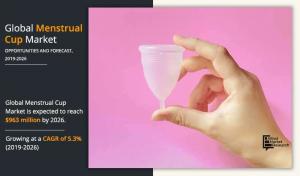Menstrual Cup Market Continues to Blossom, Set to Exceed $963 Million by 2026
"Menstrual Cup Market Continues to Blossom, Set to Exceed $963 Million by 2026 with Growing Demand for Sustainable and Cost-Effective Menstrual Products"
PORTLAND, OREGON, UNITED STATES, May 12, 2023 /EINPresswire.com/ -- Menstrual cups have gained popularity as a sustainable and eco-friendly alternative to traditional menstrual products such as tampons and pads. According to a report by Allied Market Research, the global menstrual cup market size was valued at approximately $632 million in 2018 and is projected to reach $963 million by 2026, registering a CAGR of 5.3% from 2019 to 2026.
The growing awareness about the environmental impact of disposable menstrual products and the advantages of menstrual cups, such as reduced waste, cost-effectiveness, and convenience, are among the key factors driving the growth of the menstrual cup market. In addition, the increasing number of initiatives by governments and non-governmental organizations to promote menstrual hygiene and the use of sustainable menstrual products are also expected to boost market growth in the coming years.
𝐃𝐨𝐰𝐧𝐥𝐨𝐚𝐝 𝐏𝐃𝐅 𝐁𝐫𝐨𝐜𝐡𝐮𝐫𝐞 𝐚𝐭: https://www.alliedmarketresearch.com/request-sample/5388
Key Market Players
𝘉𝘓𝘖𝘚𝘚𝘖𝘔 𝘊𝘜𝘗, 𝘋𝘐𝘝𝘈 𝘐𝘕𝘛𝘌𝘙𝘕𝘈𝘛𝘐𝘖𝘕𝘈𝘓 𝘐𝘕𝘊., 𝘍𝘓𝘌𝘜𝘙𝘊𝘜𝘗, 𝘐𝘕𝘛𝘐𝘔𝘐𝘕𝘈, 𝘑𝘈𝘎𝘜𝘈𝘙𝘈, 𝘚.𝘙.𝘖., 𝘓𝘜𝘕𝘌 𝘎𝘙𝘖𝘜𝘗 𝘖𝘠 𝘓𝘛𝘋., 𝘓𝘌𝘕𝘈 𝘊𝘜𝘗, 𝘔𝘖𝘖𝘕𝘊𝘜𝘗 𝘓𝘛𝘋., 𝘔𝘌 𝘓𝘜𝘕𝘈 𝘎𝘮𝘣𝘏, 𝘚𝘈𝘈𝘓𝘛, 𝘓𝘓𝘊, 𝘚𝘛𝘌𝘙𝘕𝘌 (𝘚𝘐-𝘓𝘐𝘕𝘌), 𝘛𝘏𝘌 𝘍𝘓𝘌𝘟 𝘊𝘖𝘔𝘗𝘈𝘕𝘠, 𝘠𝘜𝘜𝘒𝘐 𝘊𝘖𝘔𝘗𝘈𝘕𝘠 𝘚.𝘙.𝘖.
𝐓𝐡𝐞 𝐦𝐞𝐧𝐬𝐭𝐫𝐮𝐚𝐥 𝐜𝐮𝐩 𝐦𝐚𝐫𝐤𝐞𝐭 𝐜𝐚𝐧 𝐛𝐞 𝐬𝐞𝐠𝐦𝐞𝐧𝐭𝐞𝐝 𝐛𝐚𝐬𝐞𝐝 𝐨𝐧 𝐩𝐫𝐨𝐝𝐮𝐜𝐭 𝐭𝐲𝐩𝐞, 𝐦𝐚𝐭𝐞𝐫𝐢𝐚𝐥, 𝐚𝐧𝐝 𝐝𝐢𝐬𝐭𝐫𝐢𝐛𝐮𝐭𝐢𝐨𝐧 𝐜𝐡𝐚𝐧𝐧𝐞𝐥.
Product Type:
1. Disposable: These are menstrual cups that are designed for single-use and are meant to be discarded after each cycle. They are typically made from low-cost materials such as thermoplastic elastomers (TPE).
2. Reusable: These are menstrual cups that are designed for multiple uses and can last for several years if properly maintained. They are typically made from higher quality materials such as medical-grade silicone or natural gum rubber (latex).
Material:
1. Medical-grade silicone: This is the most common material used in menstrual cups due to its high durability, flexibility, and biocompatibility. It is also hypoallergenic and easy to clean.
2. Natural gum rubber (latex): This material is biodegradable and has a high level of elasticity, making it an ideal choice for menstrual cups. However, it can cause allergic reactions in some individuals.
3. Thermoplastic elastomer (TPE): This is a low-cost alternative to silicone and latex. It is also hypoallergenic and easy to clean, but may not last as long as other materials.
Distribution Channel:
1. Online Stores: Many menstrual cup brands are sold through online retailers such as Amazon, Walmart, and other e-commerce platforms. This allows for easy accessibility and convenience for consumers.
2. Pharmacies & Retail Stores: Menstrual cups can also be found in physical stores such as pharmacies and health food stores. This allows for in-person consultation with a sales associate and the ability to physically examine the product before purchase.
𝐓𝐡𝐞 𝐦𝐞𝐧𝐬𝐭𝐫𝐮𝐚𝐥 𝐜𝐮𝐩 𝐦𝐚𝐫𝐤𝐞𝐭 𝐜𝐚𝐧 𝐚𝐥𝐬𝐨 𝐛𝐞 𝐬𝐞𝐠𝐦𝐞𝐧𝐭𝐞𝐝 𝐛𝐚𝐬𝐞𝐝 𝐨𝐧 𝐠𝐞𝐨𝐠𝐫𝐚𝐩𝐡𝐲:
North America: The North American menstrual cup market is expected to dominate the global market due to the high adoption of sustainable products and the increasing number of manufacturers in the region. The United States, Canada, and Mexico are the key markets in this region.
Europe: Europe is expected to witness significant growth in the menstrual cup market due to the rising awareness about menstrual health and hygiene and the growing demand for eco-friendly menstrual products in the region. Germany, France, the United Kingdom, Italy, Russia, Poland, and the Czech Republic are the major markets in this region.
Asia-Pacific: The Asia-Pacific menstrual cup market is expected to witness significant growth due to the growing awareness about menstrual health and hygiene and the increasing demand for eco-friendly menstrual products in the region. Japan, China, India, and Australia are the key markets in this region.
LAMEA: The LAMEA (Latin America, Middle East, and Africa) menstrual cup market is expected to witness moderate growth due to the increasing awareness about menstrual health and hygiene in these regions. Brazil, Saudi Arabia, and South Africa are the major markets in this region.
𝐅𝐑𝐄𝐐𝐔𝐄𝐍𝐓𝐋𝐘 𝐀𝐒𝐊𝐄𝐃 𝐐𝐔𝐄𝐒𝐓𝐈𝐎𝐍𝐒?
1. What are the benefits of using menstrual cups over traditional menstrual products?
2. What are the key factors driving the growth of the menstrual cup market?
3. How does the menstrual cup market differ in different regions of the world?
4. What materials are commonly used to make menstrual cups, and what are their pros and cons?
5. What are the most popular distribution channels for menstrual cups, and how are they evolving?
6. How do reusable menstrual cups compare to disposable menstrual cups in terms of cost and sustainability?
7. What are the most important regulatory considerations for menstrual cup manufacturers?
8. How have consumer attitudes towards menstrual cups changed over time, and what has driven these changes?
9. What challenges do menstrual cup manufacturers face in terms of production, marketing, and distribution?
10. What innovations are currently being developed in the menstrual cup market, and how might they change the industry in the future?
𝐁𝐮𝐲 𝐏𝐫𝐞𝐦𝐢𝐮𝐦 𝐂𝐨𝐩𝐲 𝐨𝐟 𝐌𝐞𝐧𝐬𝐭𝐫𝐮𝐚𝐥 𝐂𝐮𝐩 𝐌𝐚𝐫𝐤𝐞𝐭 𝐆𝐫𝐨𝐰𝐭𝐡 𝐑𝐞𝐩𝐨𝐫𝐭 𝐚𝐭: https://www.alliedmarketresearch.com/menstrual-cup-market/purchase-options
David Correa
Allied Analytics LLP
+1 800-792-5285
email us here
Legal Disclaimer:
EIN Presswire provides this news content "as is" without warranty of any kind. We do not accept any responsibility or liability for the accuracy, content, images, videos, licenses, completeness, legality, or reliability of the information contained in this article. If you have any complaints or copyright issues related to this article, kindly contact the author above.

